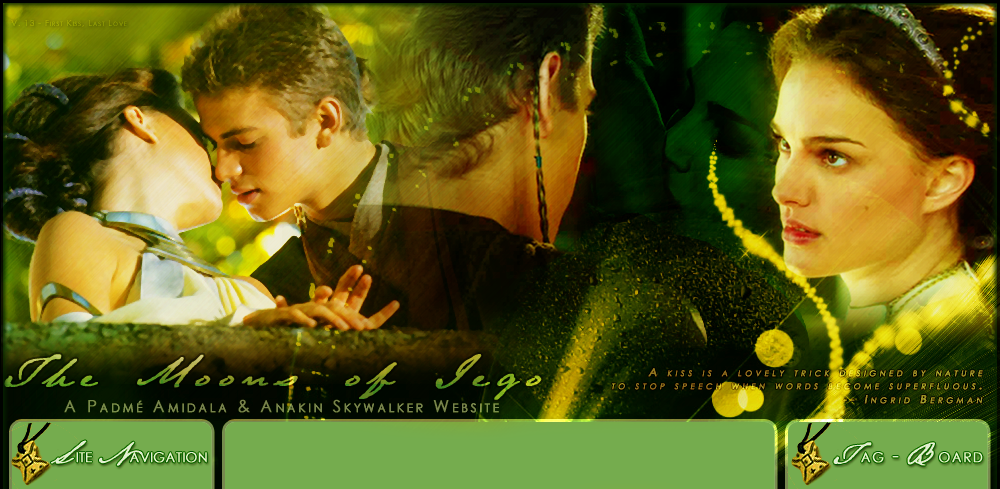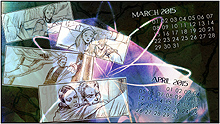



IMAGE |
WALLPAPER |
FAN ART |
FAN FICTION |
Rush by Love and Rock Music. (TCW) The first half of "Destroy Malevolence," as Anakin and Padmé make their way towards each other. |
P/A SITE
|
|
CALENDAR
|
 |

ESSAYS & DISCUSSION
-------------------------------------------
The Perils of Padmé:
The Short Life and Fast Times Of A Tragic Heroine
by lazypadawan
------------------------------
For years fans have wondered who was the mysterious, unnamed mother of Luke and Leia. The only hint of who she had been was Leia's vague impressions expressed in Return of the Jedi: kind, very beautiful, but sad.
Finally with the release of The Phantom Menace, we were introduced to her: Queen Amidala of the Naboo, otherwise known as Padmé Amidala Naberrie. The young girl-woman in The Phantom Menace and Attack of the Clones was in many ways in the mold of her future daughter: smart, wise, resourceful, brave, and if need be, good in a fight. But with Revenge of the Sith, she joins a sisterhood of memorable women who suffer tragedy.
Padmé shares common traits with many traditional tragic heroines but in some ways she is unique. Traditionally, a tragic heroine suffers because of her own tragic flaw and/or the flaws of someone else, even her society or culture. Aristotle referred to this flaw as "harmatia," the accurate definition of which is closer to "mistake," "error," or "failing" than an innate flaw. Aristotle believed the flaw must result from something that is a central part of one's virtue, which goes wrong due to a misunderstanding or lack of knowledge.1 Antigone suffers because of her devotion to divine law, which demands she bury her brother, bringing her into conflict with the inhumane decree of King Creon, who forbade burial.2 Ophelia suffers because of Hamlet's inner conflict. Juliet's death is brought about not only because of her love for Romeo but also because of the feud between the Montagues and the Capulets.
If Padmé had personal flaws according to Aristotle's definition, some may argue they would be her naivete, her innocence, her trust in the Republic as it was rotting away from within, her trust in Palpatine, and even her love for Anakin. Padmé tends to put a lot of faith in the innate good of others; Obi-Wan notes in the young readers' version of the Revenge of the Sith novelization that Padmé "always believes the best of everyone, until she's forced to see the worst. Such faith should be a strength, not a weakness."3 She suffers because of that faith in her leaders, the Republic, and in Anakin, because they all fail her. In fact, Padmé embodies the Republic's ideals and virtues: democracy, restraint over tyranny, and working for the good of others. Padmé is also associated with youth and beauty as well as wisdom. She comes from a world teeming with life and as the female lead of the prequel trilogy, as well as the mother of the heroes of the classic trilogy, she embodies the feminine, the anima.
At the beginning of the saga, the Republic was in its golden age. Padmé�'s homeworld of Naboo was an opulent and verdant world with stunning architecture and natural wonders. Its people were dressed nearly as elaborately as its ruler. Even the sleek spacecraft reflected a great appreciation for beauty. Women are seen everywhere in the prequels, in all stations of life; pilots, Jedi, Senators, handmaidens, bodyguards, and mothers. But the galaxy was changing and the young queen was caught in the middle of that change. She is brought in as a pawn in a political game that she understands too late. She is also introduced to the boy destined to change her life forever.
For most of the prequel trilogy, Padmé has been in constant danger and in need of protection. The Phantom Menace and Attack Of The Clones have a pattern. 1. Padmé is rescued, 2. Padmé is placed under protection, and 3. Padmé willingly leaves that protection to take action herself. She spends a great deal of time courting her fate despite the efforts of others to protect her. In The Phantom Menace, she is rescued from the Trade Federation and is able to remain on Coruscant where she is safe. Yet she chooses to return to Naboo to engage the Trade Federation in battle and re-take her planet. In Attack of the Clones, she is rescued after two attempts on her life and is put into Anakin's protection. Yet she chooses to first go to Tatooine with Anakin then she convinces him to go with her to Geonosis to save Obi-Wan, where once again she is forced to fight for her life. She narrowly avoids being killed by beasts, survives a battle that kills several Jedi, and then avoids serious injury after falling out of a ship. She gives several references to dying in the films. In The Phantom Menace, she mentions twice that her people on Naboo were dying. In Attack of the Clones, she mentions death four times during her love pledge to Anakin: "I'm not afraid to die...I've been dying a little bit each day since you came back into my life...our lives are about to be destroyed anyway...before we die I want you to know."
At the same time, the feminine energy, the anima, is slowly being destroyed. In Attack of the Clones, Zam Wessel, Cordé the handmaiden, and most importantly, Anakin's mother Shmi, die violently. In Revenge of the Sith, the final phase of destruction takes place. We see the betrayal and murder of two female Jedi: Stass Allie and Aayla Secura. Aayla in particular is murdered in an especially gruesome way, shot repeatedly in close range by several clonetroopers. Ironically she was on Felucia, a world teeming with life and giant blooming flowers. It climaxes with Padmé's death after performing the ultimate feminine act, giving birth. She dies far from her fertile living world where she'd planned to have her child(ren), in a cold environment deep in space, and attended to by droids that cannot understand what is wrong with her.
Unlike the pattern with previous two prequels, Padmé does not need rescuing from external threats in Revenge of the Sith. Dooku is dead and the Trade Federation seems to have forgotten about her. The irony is the external dangers from which Anakin seeks to protect her from throughout the prequel trilogy do not bring about her end. It's not the Trade Federation or hired assassins but her own shattered soul. However, like the other films, she chooses to leave her haven, this time on Coruscant, to take charge when things are dire. When Captain Typho volunteers to go with her, she refuses, saying the matter is personal and that she is no longer in danger. Finally, she could no longer avoid her destiny.
Some fans complained that Padmé was marginalized in Revenge of the Sith, but her isolation makes sense in the context of the story. Here she was at the height of her feminine power, pregnant and able to share a form of subconscious bond on occasion with Anakin. Yet the Empire-to-be has no place for her. She is trapped and alone.
Padmé's death recalls traditional tragic heroines such as Isolde, who dies of a broken heart after her love Tristan dies. In Arthurian legend, Elaine The Lady of Shallot dies of love for Lancelot.4 In fact, dying of a broken heart is part of many legends, folk tales, and ghost stories. Others see parallels with Othello's Desdemona, who like Padmé is strangled by a husband who believes she has betrayed by him. Others view Padmé as being similar to Ophelia, who commits suicide after Hamlet rejects her. Because Ophelia and Desdemona are commonly viewed as passive victims, and Padmé had been a proactive character, some felt her death did not befit her character.
There is a literal way of looking at Padmé's death and a symbolic way. Padmé was as much a symbiont with her time and place as she was with Anakin. When the Republic era passes, she passes. In a cut scene from Attack of the Clones, the lesson in Padmé's story about the refugees she tried to help as a child was that those who cannot adapt die. She cannot adapt to this new galaxy. Moreover, she refuses to adapt. She tells Anakin he is going down a path she cannot follow. She bitterly utters, "So this is how liberty dies, with thunderous applause," after Palpatine crowns himself Emperor before a cheering Senate. When Vader in a rage cuts off her breathing, it symbolizes that the Empire, as personified by Anakin, is killing her.
She suffers not only the death throes of the Republic and its ideals, she also suffers with the physical and spiritual pain Anakin endures in his transformation into the Darth Vader we know from the classic trilogy. The film intercuts between Vader's agony on the operating table and Padmé's dying moments as she gives birth. When Vader's transformation is complete, she dies.
With Padmé gone, the aesthetics of the Star Wars universe changes: we see the utilitarian set of the Star Destroyer, the beauty of the earlier ships gone. The beautiful, colorful, and elegant costumes have been replaced by simpler and more drab garments in shades of gray. Even the last time we see Naboo in the prequels, all of the citizens are dressed in funereal black. We see of glimpse of the Empire's new order, a Star Destroyer crew made up entirely of men. Instead of the natural beauty of a planet, we witness the skeletal beginnings of the Death Star.
Yet in the end, unlike most other tragic heroines, Padmé wins. Those who dismiss Padmé as weak should consider this alternative view of Desdemona: "Desdemona's goodness furthermore is not simply passive or weak but an act of will...her refusal to blame Othello for his terrible treatment of her...must not be viewed as simply subservience but as a self-willed refusal to accept a bad opinion of the husband she has chosen...she stands by her love for him as something sacred, with a martyr-like determination: she tells Emilia, 'his unkindness may defeat my life/But never taint my love.'"5 Padmé, through her own will, refuses to believe Anakin is unredeemable. Ultimately Padmé is right about Anakin; there was still good in him and he could be turned back to the light. Her children bring down the Empire and restore the old values of the Republic. Padmé's life may have been short but she was never truly a victim.
Endnotes:
1. Struck, Peter T. "Oedipus as the Ideal Tragic Hero," http://www.classics.upenn.edu/myth/tragedy/oedhero.php, 2000.
2. Answers.com, "Daughter of Oedipus."
3. Wrede, Patricia C. Star Wars Episode III: Revenge of the Sith, Scholastic, 2005, page 153.
4. womenmyth.com, "Women of Arthurian Mythology."
5. Lewis, Liz, "Shakespeare's Women: Shakespeare's Treatment of Women in the Tragedies of Hamlet, Othello, and Antony and Cleopatra," http://www.english-literature.org/essays/shakespeare_women.html.
-
<<back to essays & discussion